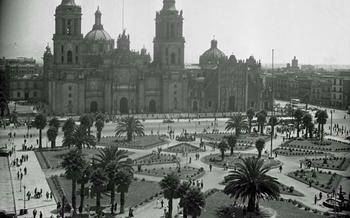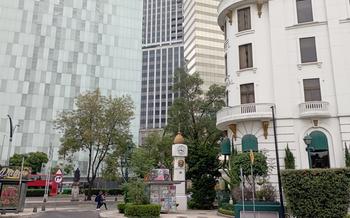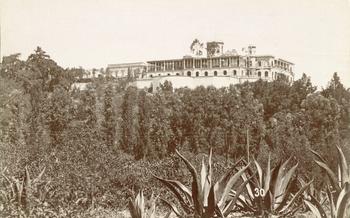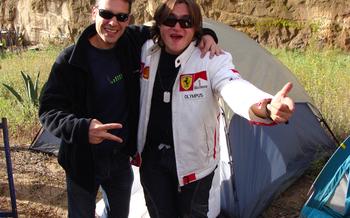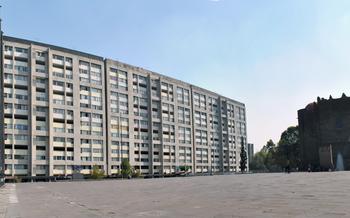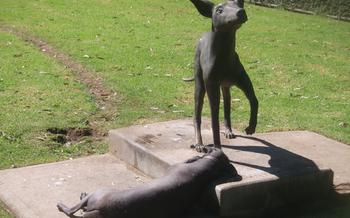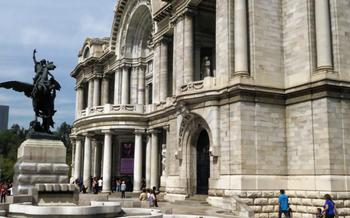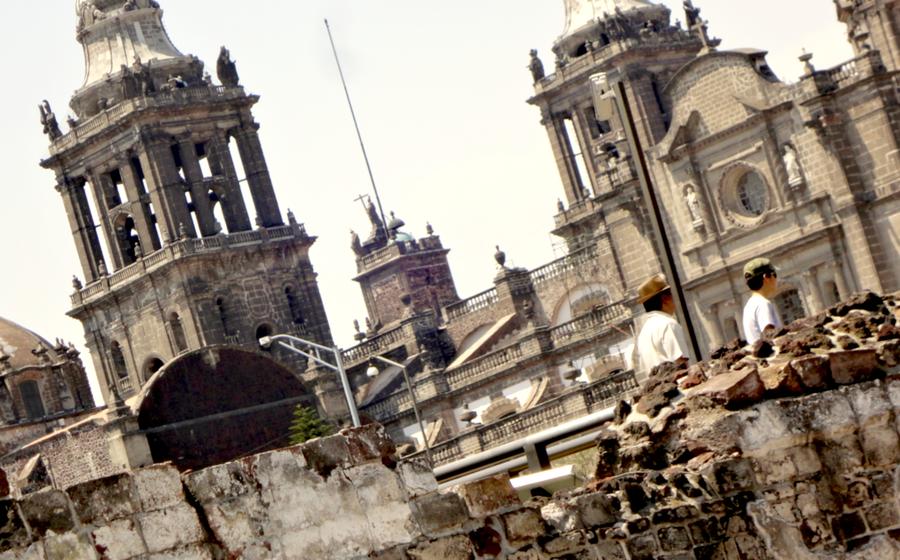
Catedral Metropolitana
- Catedral Metropolitana: A Majestic Monument in the Heart of Mexico City
- Plaza de la Constitución: A Historical Square with Vibrant Surroundings
- Museo del Estanquillo: A Quirky Museum with a Unique Collection
- Zócalo: The Pulsating Heart of Mexico City
- Paseo de la Reforma: A Grand Avenue with Historical Landmarks
- Torre Latinoamericana: Panoramic Views from the Historic Skyscraper
- Mercado de Artesanías La Ciudadela: A Market for Traditional Mexican Crafts
- Frida Kahlo Museum: Exploring the Life and Art of Frida Kahlo
- Chapultepec Park: A Vast Urban Park with Cultural Attractions
- Museo Soumaya: A Modern Museum with a Diverse Collection
- Xochimilco: A Colorful Floating Garden with Traditional Boats
- Insider Tip: Join a Free Walking Tour for Local Insights
Catedral Metropolitana: A Majestic Monument in the Heart of Mexico City
In the heart of Mexico City's historical center, stands the Catedral Metropolitana, an iconic symbol of the city's rich history and religious heritage. With its awe-inspiring architecture, significant religious relics, and must-see attractions, the Catedral Metropolitana is an essential destination for visitors seeking to immerse themselves in the cultural and spiritual essence of Mexico. Its historical significance, stemming from its construction during the Spanish colonial period, blends seamlessly with its architectural grandeur, showcasing intricate Gothic and Baroque styles. As the seat of the Roman Catholic Archdiocese of Mexico, the cathedral holds deep religious importance, attracting pilgrims and worshippers from around the world.
Plaza de la Constitución: A Historical Square with Vibrant Surroundings
Location and significance: Located in the heart of Mexico City, the Plaza de la Constitución, also known as the Zócalo, is the city's main square and a symbol of its historical and cultural significance. Surrounded by some of the city's most important landmarks, the square has witnessed countless events that have shaped the history of Mexico.
Monuments and landmarks: The plaza is home to several notable monuments and landmarks, including the Metropolitan Cathedral, the Templo Mayor Museum, the National Palace, and the Supreme Court of Justice building. The square is also adorned with various statues, fountains, and sculptures that pay homage to important figures and events in Mexican history.
Cultural events and performances: The Plaza de la Constitución is a popular venue for cultural events, concerts, and performances. Throughout the year, the square hosts a variety of festivals, celebrations, and demonstrations, showcasing Mexico's rich cultural heritage. From traditional dance performances to political rallies, the square is a hub of activity and a place where history and culture converge.
Lively atmosphere: With its vibrant atmosphere, street vendors, and bustling crowds, the Plaza de la Constitución is a place where locals and tourists alike come together to experience the essence of Mexico City. The square is always buzzing with activity, whether it's during the day when people gather to admire the architecture or in the evening when the square transforms into a lively gathering spot filled with music, laughter, and street performers.
Museo del Estanquillo: A Quirky Museum with a Unique Collection
The Museo del Estanquillo is a unique and quirky museum in Mexico City that offers a fascinating glimpse into Mexican art and culture. Founded in 1964 by renowned Mexican writer and collector Carlos Monsiváis, the museum showcases a diverse collection of over 20,000 artifacts, including paintings, sculptures, photographs, and ephemera.
The museum's collection is eclectic and often humorous, reflecting Monsiváis's personal taste and fascination with popular culture. Visitors can explore exhibits on Mexican cinema, bullfighting, political satire, and even kitsch, gaining insights into the country's rich cultural heritage and sense of humor.
One of the highlights of the museum is its collection of Mexican folk art, including colorful alebrijes, whimsical clay figures, and traditional toys. These handcrafted objects offer a glimpse into the creativity and artistry of Mexico's indigenous communities.
The Museo del Estanquillo is a must-visit for anyone interested in Mexican art, culture, and history. Its unique collection, quirky exhibits, and personal touch make it a truly memorable experience.
Zócalo: The Pulsating Heart of Mexico City
A Historic Square Steeped in Cultural Significance
At the heart of Mexico City lies the Zócalo, a vast and iconic square that serves as the city's cultural and historical epicenter. Encompassing an area of over 46,000 square meters, it is one of the largest public squares in the world, capable of accommodating multitudes of people.
The Zócalo's rich history dates back to the Aztec era when it was known as the Templo Mayor, a sacred precinct dedicated to the Aztec gods. Following the Spanish conquest, the square was transformed into a central plaza, serving as the focal point of the newly established Spanish colonial city.
Today, the Zócalo is a vibrant and multifaceted space that hosts a multitude of events, festivals, and protests. It is surrounded by some of Mexico City's most iconic landmarks, including the Catedral Metropolitana, the Palacio Nacional, and the Templo Mayor Museum.
The Zócalo is a place where history, culture, and modernity intertwine. It is a place where locals and tourists alike gather to celebrate, protest, and simply soak in the vibrant atmosphere. A visit to the Zócalo is an absolute must for anyone seeking to experience the true essence of Mexico City.
Paseo de la Reforma: A Grand Avenue with Historical Landmarks
Paseo de la Reforma, stretching from the historic center to Chapultepec Park, is one of Mexico City's most iconic avenues, embodying the city's rich history, culture, and modernity. Created in the 1860s by Emperor Maximilian I, the avenue reflects the influence of French urban planning with its wide boulevards, manicured gardens, and imposing monuments.
Strolling along Paseo de la Reforma, visitors are greeted by an array of landmarks that tell the story of Mexico's past and present. The iconic Angel of Independence, a towering monument topped by a golden victory goddess, commemorates Mexico's independence from Spain. The majestic Palacio de Bellas Artes, renowned for its eclectic architectural style and stunning murals by Diego Rivera, is a cultural hub hosting world-class performances and exhibitions.
Other notable landmarks along the avenue include the Diana the Huntress Fountain, a symbol of Mexican femininity; the Monument to Christopher Columbus, a reminder of the country's colonial past; and the Fuente de la Cibeles, a replica of the famous fountain in Madrid, Spain.
Beyond its historical significance, Paseo de la Reforma is also a vibrant cultural and commercial center. Lined with elegant boutiques, trendy restaurants, and prestigious hotels, the avenue exudes a cosmopolitan atmosphere. Cultural institutions such as the Museo Nacional de Antropología and the Museo Soumaya, renowned for their extensive collections of Mexican and international art, are also located along this grand boulevard.
With its historical landmarks, cultural attractions, and vibrant atmosphere, Paseo de la Reforma is a must-visit destination for anyone exploring Mexico City. It offers a glimpse into the city's rich past, showcases its vibrant cultural scene, and provides a glimpse into its modern, cosmopolitan identity.
Torre Latinoamericana: Panoramic Views from the Historic Skyscraper
Amidst the vibrant streets of Mexico City, the Torre Latinoamericana stands tall, an iconic symbol of Mexican resilience and architectural prowess. Completed in 1956, this 44-story skyscraper was once the tallest building in Latin America, a testament to the city's growing stature.
History and Construction: The Torre Latinoamericana's construction was a daring feat of engineering, completed during a time when Mexico was experiencing rapid economic growth. The building's design was meticulously planned to withstand earthquakes, a common occurrence in the region. Its unique diagonal steel frame, inspired by the Empire State Building, allowed it to sway during seismic activity, effectively dissipating the energy and minimizing damage.
Architectural Style and Design: The Torre Latinoamericana's architectural style reflects a blend of modernism and Art Deco influences. Its exterior features clean lines, geometric shapes, and decorative elements, showcasing the architectural trends of the mid-20th century. The building's distinctive crown, reminiscent of a Mayan pyramid, adds a touch of local cultural heritage to its overall design.
Observation Deck and Panoramic Views: Ascend to the Torre Latinoamericana's observation deck, located on the 44th floor, and be rewarded with breathtaking panoramic views of Mexico City. From this vantage point, visitors can admire the city's vast expanse, with its historic center, sprawling neighborhoods, and distant mountain ranges. The observation deck offers a unique perspective, allowing visitors to appreciate the city's layout and landmarks from above.
Symbol of Mexican Resilience: The Torre Latinoamericana has become a symbol of Mexican resilience, having withstood several major earthquakes throughout its history, including the devastating 1985 Mexico City earthquake. Its ability to endure these seismic events has earned it the nickname "the Unsinkable Ship," a testament to its exceptional engineering and construction.
Mercado de Artesanías La Ciudadela: A Market for Traditional Mexican Crafts
Located in the heart of Mexico City, the Mercado de Artesanías La Ciudadela is a vibrant and colorful market known for its vast collection of traditional Mexican handicrafts and souvenirs. With over 300 stalls lining its cobblestone streets, the market offers a unique and immersive shopping experience.
Strolling through the aisles, you'll find an array of handmade items, from intricate pottery and woven textiles to colorful masks, jewelry, and leather goods. Each piece is a testament to the skill and artistry of local artisans and craftsmen, who showcase their creations with pride.
In addition to its vibrant atmosphere, the Mercado de Artesanías La Ciudadela is also a great place to support local businesses and artisans. By purchasing souvenirs and handicrafts from the market, you'll be directly contributing to the preservation of traditional Mexican crafts and ensuring that these artisans can continue to practice their trade.
To fully immerse yourself in the local culture, don't forget to engage in the time-honored tradition of bargaining. While prices are generally fair, haggling is expected and can be a fun and rewarding experience. Remember to approach the negotiations with respect and a smile, and be prepared to walk away if the price doesn't meet your budget.
Whether you're looking for a unique souvenir, a special gift, or simply want to experience the vibrant energy of a traditional Mexican market, the Mercado de Artesanías La Ciudadela is a must-visit destination.
Frida Kahlo Museum: Exploring the Life and Art of Frida Kahlo
The Frida Kahlo Museum, also known as the Blue House, is a must-visit destination for those interested in the life and work of one of Mexico's most iconic artists. Located in the vibrant neighborhood of Coyoacán, the museum was once the home of Frida Kahlo and her husband, the renowned muralist Diego Rivera.
Step into the cobalt blue walls of the Frida Kahlo Museum and embark on a journey through the artist's personal belongings, artwork, and life story. Admire her vibrant self-portraits, which offer a glimpse into her inner struggles and triumphs. Discover the influences that shaped her unique style, from Mexican folk art to surrealism.
Immerse yourself in the Frida Kahlo experience by exploring her studio, where she created some of her most famous works. See the easel where she painted and the wheelchair she used during her periods of illness. Learn about her tumultuous relationship with Diego Rivera and the challenges she faced as a woman and an artist in a male-dominated society.
The Frida Kahlo Museum is a testament to the enduring legacy of one of Mexico's most celebrated artists. Through her art, Frida Kahlo expressed her pain, her joy, and her unwavering resilience. Visiting the museum is a chance to gain a deeper understanding of her life and work, and to appreciate the contributions she made to Mexican and international art.
Chapultepec Park: A Vast Urban Park with Cultural Attractions
Spanning over 686 hectares, Chapultepec Park is a sprawling green oasis in the heart of Mexico City. Known as the lungs of the city, it offers a tranquil escape from the bustling urban landscape and a wealth of cultural attractions for visitors.
Within the park's expansive grounds, history buffs can explore the Castillo de Chapultepec, a former royal residence that now houses the Museo Nacional de Historia. The castle offers panoramic views of the city and a glimpse into Mexico's rich past. Another must-see attraction is the Museo Nacional de Antropología, renowned for its extensive collection of pre-Columbian artifacts and insights into various Mexican cultures.
For art enthusiasts, the Museo de Arte Moderno and the Museo Tamayo offer a showcase of modern and contemporary Mexican art. The park also boasts beautiful gardens, including the Jardín Botánico, which features a diverse collection of plants from around the world.
Whether you're seeking cultural enrichment, a peaceful retreat, or a fun day out, Chapultepec Park has something to offer everyone.
Museo Soumaya: A Modern Museum with a Diverse Collection
Amidst the vibrant cultural landscape of Mexico City, the Museo Soumaya stands as a testament to the passion and vision of its founder, Carlos Slim. Housed in a striking modern building, the museum boasts an extensive collection of over 66,000 artworks, spanning various periods and styles. From pre-Columbian sculptures to Renaissance masterpieces, European Impressionist paintings to contemporary installations, the Museo Soumaya offers a diverse and captivating journey through the history of art.
One of the highlights of the museum is its impressive collection of works by Mexican artists, including Diego Rivera, Frida Kahlo, and José Clemente Orozco. These iconic figures of the Mexican art scene are represented through a vast array of paintings, murals, and sculptures, providing visitors with a comprehensive insight into their artistic contributions and the cultural context that shaped their work.
The Museo Soumaya's unique architectural design, conceived by renowned Mexican architect Fernando Romero, is a sight to behold. The building's sinuous curves and metallic exterior create a striking contrast with the surrounding cityscape, while its central atrium, flooded with natural light, provides a dramatic backdrop for the displayed artwork.
Admission to the Museo Soumaya is free of charge, making it accessible to visitors from all walks of life. This commitment to inclusivity reflects the museum's mission to promote cultural appreciation and education, ensuring that art is not only accessible but also enjoyed by a broad audience.
Xochimilco: A Colorful Floating Garden with Traditional Boats
Xochimilco, a UNESCO World Heritage Site, is a unique and colorful destination located just south of Mexico City. This ancient network of canals and waterways, dating back to pre-Hispanic times, is home to a vibrant community of people who live and work on the water.
Take a traditional trajinera, a colorful gondola-like boat, and glide through the canals, passing by lush vegetation, floating gardens, and traditional houses. Along the way, you'll encounter mariachi bands serenading visitors with traditional Mexican music, adding to the festive atmosphere.
Visit the local markets to sample delicious street food and handicrafts, or stop at one of the many restaurants and cafes along the canals. Xochimilco is a great place to relax and soak up the local culture, while enjoying the beauty of the natural surroundings.
Insider Tip: Arrive early to avoid the crowds, especially on weekends. Take a boat tour to the more remote areas to experience the tranquility and beauty of the canals away from the hustle and bustle of the main channels.
Insider Tip: Join a Free Walking Tour for Local Insights
To delve deeper into the rich tapestry of Mexico City's history, culture, and hidden gems, consider joining a free walking tour. These tours, often led by passionate local guides, offer a unique perspective on the city's landmarks, traditions, and everyday life.
Recommended tour companies include "Mexico City Free Walking Tour" and "Free Tour Mexico." Tours typically start from the Zócalo, the city's main square, and cover various neighborhoods, including the historic center, Chapultepec Park, and the Roma district.
During the tour, you'll not only learn about the city's iconic landmarks but also discover hidden gems and local favorites, such as traditional markets, street food stalls, and charming cafes. Your guide will provide insights into Mexican history, culture, and customs, as well as personal anecdotes and recommendations.
Joining a free walking tour is a fantastic way to get an insider's perspective on Mexico City, meet fellow travelers, and make the most of your time in this vibrant metropolis. Remember to tip your guide at the end of the tour to show your appreciation for their knowledge and hospitality.
